2021 VOLKSWAGEN TRANSPORTER lock
[x] Cancel search: lockPage 387 of 486
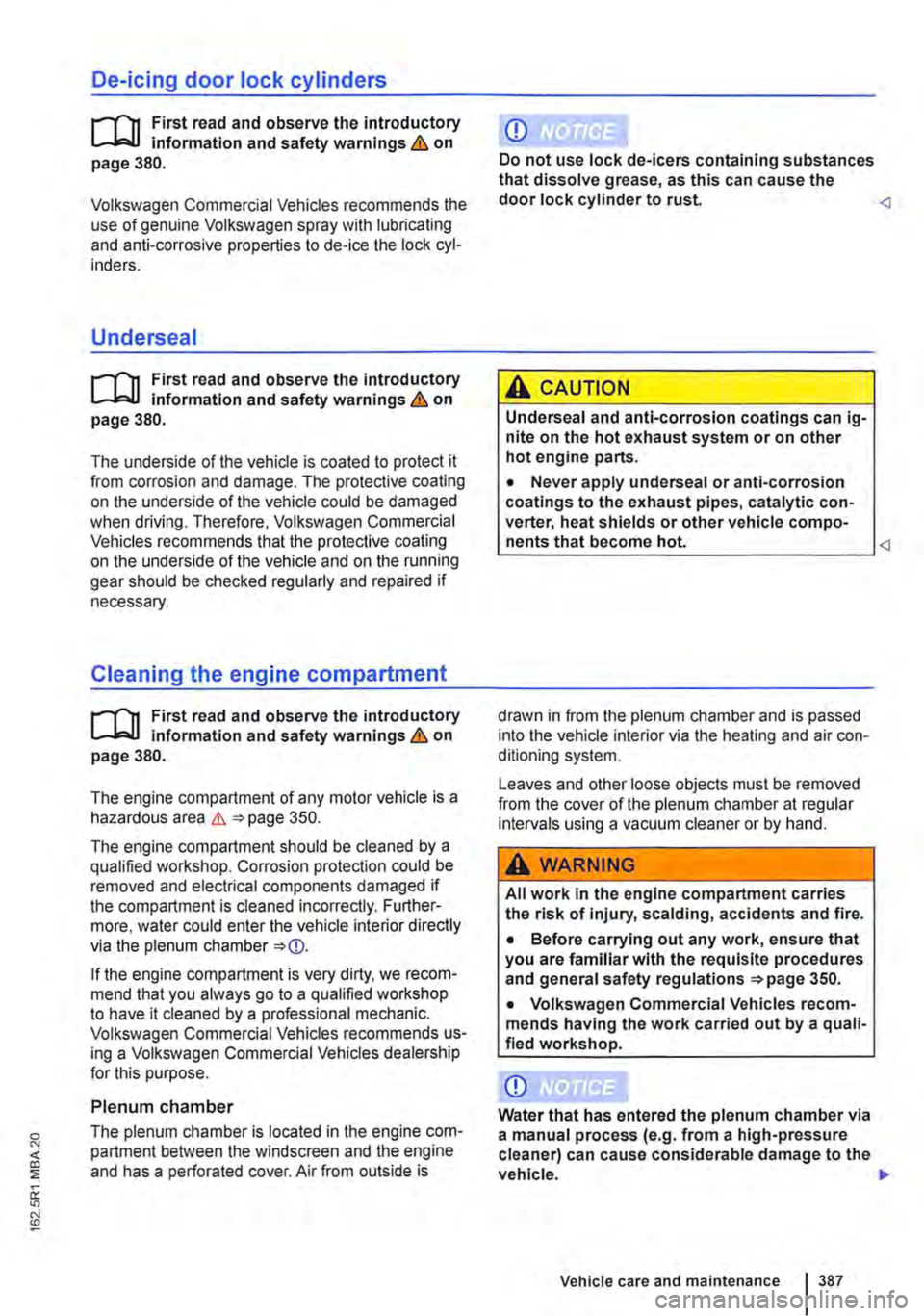
De-icing door lock cylinders
....-m First read and observe the introductory L-I=JJ information and safety warnings & on page 380.
Volkswagen Commercial Vehicles recommends the use of genuine Volkswagen spray with lubricating and anti-corrosive properties to de-ice the lock cyl-inders.
Undersea I
....-m First read and observe the introductory L-I=JJ information and safety warnings & on page 380.
The underside of the vehicle is coated to protect it from corrosion and damage. The protective coating on the underside of the vehicle could be damaged when driving. Therefore, Volkswagen Commercial Vehicles recommends that the protective coating on the underside of the vehicle and on the running gear should be checked regularly and repaired if necessary.
Cleaning the engine compartment
....-m First read and observe the introductory L-I=JJ information and safety warnings & on page 380.
The engine compartment of any motor vehicle is a hazardous area L1l. 350.
The engine compartment should be cleaned by a qualified workshop. Corrosion protection could be removed and electrical components damaged if the compartment is cleaned incorrectly. Further-more, water could enter the vehicle interior directly via the plenum chamber
If the engine compartment is very dirty, we recom-mend that you always go to a qualified workshop to have it cleaned by a professional mechanic. Volkswagen Commercial Vehicles recommends us-ing a Volkswagen Commercial Vehicles dealership for this purpose.
Plenum chamber
The plenum chamber is located in the engine com-partment between the windscreen and the engine and has a perforated cover. Air from outside is
CD·
Do not use lock de-leers containing substances that dissolve grease, as this can cause the door lock cylinder to rust.
Undersea! and anti-corrosion coatings can ig-nite on the hot exhaust system or on other hot engine parts.
• Never apply undersea! or anti-corrosion coatings to the exhaust pipes, catalytic con-verter, heat shields or other vehicle compo-nents that become hot.
Leaves and other loose objects must be removed from the cover of the plenum chamber at regular intervals using a vacuum cleaner or by hand.
A WARNING
All work in the engine compartment carries the risk of injury, scalding, accidents and fire.
• Before carrying out any work, ensure that you are familiar with the requisite procedures and general safety regulations 350.
• Volkswagen Commercial Vehicles recom-mends having the work carried out by a quali-fied workshop.
CD
Water that has entered the plenum chamber via a manual process (e.g. from a high-pressure cleaner) can cause considerable damage to the
vehicle. "'
Vehicle care and maintenance I 387
Page 399 of 486
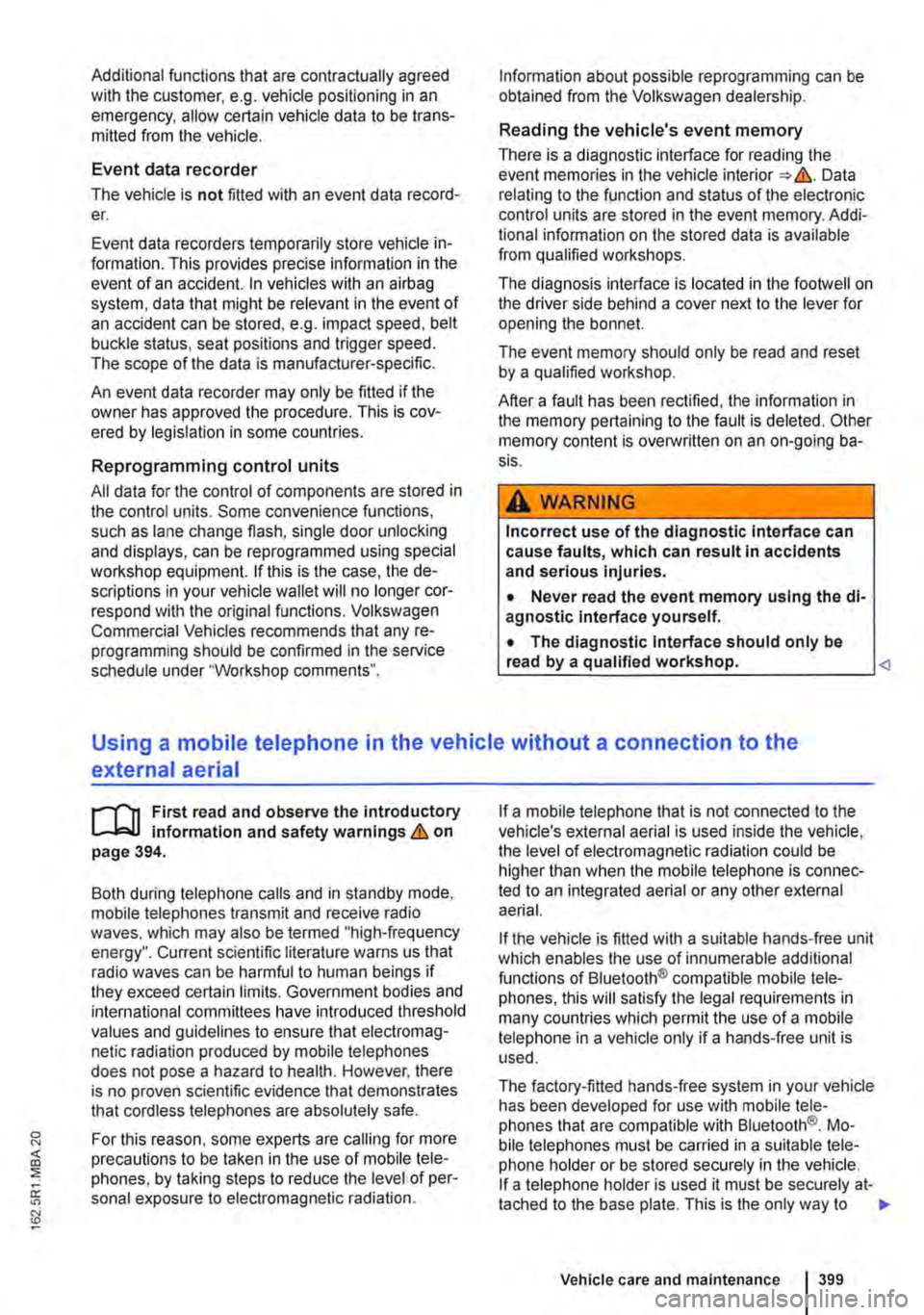
Additional functions that are contractually agreed with the customer, e.g. vehicle positioning in an emergency, allow certain vehicle data to be trans-mitted from the vehicle.
Event data recorder
The vehicle is not fitted with an event data record-er.
Event data recorders temporarily store vehicle in-formation. This provides precise information in the event of an accident. In vehicles with an airbag system, data that might be relevant in the event of an accident can be stored, e.g. impact speed, belt buckle status, seat positions and trigger speed. The scope of the data is manufacturer-specific.
An event data recorder may only be fitted if the owner has approved the procedure. This is cov-ered by legislation in some countries.
Reprogramming control units
All data for the control of components are stored in the control units. Some convenience functions, such as lane change flash, single door unlocking and displays, can be reprogrammed using special workshop equipment. If this is the case, the de-scriptions in your vehicle wallet will no longer cor-respond with the original functions. Volkswagen Commercial Vehicles recommends that any re-programming should be confirmed in the service schedule under "Workshop comments".
Information about possible reprogramming can be obtained from the Volkswagen dealership.
Reading the vehicle's event memory
There is a diagnostic interface for reading the event memories in the vehicle interior &. Data relating to the function and status of the electronic control units are stored in the event memory. Addi-tional information on the stored data is available from qualified workshops.
The diagnosis interface is located in the footwell on the driver side behind a cover next to the lever for opening the bonnet.
The event memory should only be read and reset by a qualified workshop.
After a fault has been rectified, the information in the memory pertaining to the fault is deleted. Other memory content is overwritten on an on-going ba-sis.
A WARNING
Incorrect use of the diagnostic Interface can cause faults, which can result in accidents and serious injuries.
• Never read the event memory using the di-agnostic Interface yourself.
• The diagnostic Interface should only be read by a qualified workshop.
external aerial
,...--.m First read and observe the introductory L--I=>U information and safety warnings & on page 394.
Both during telephone calls and in standby mode, mobile telephones transmit and receive radio waves, which may also be termed "high-frequency energy". Current scientific literature warns us that radio waves can be harmful to human beings if they exceed certain limits. Government bodies and international committees have introduced threshold values and guidelines to ensure that electromag-netic radiation produced by mobile telephones does not pose a hazard to health. However, there is no proven scientific evidence that demonstrates that cordless telephones are absolutely safe.
For this reason, some experts are calling for more precautions to be taken in the use of mobile tele-phones, by taking steps to reduce the level of per-sonal exposure to electromagnetic radiation.
If a mobile telephone that is not connected to the vehicle's external aerial is used inside the vehicle, the level of electromagnetic radiation could be higher than when the mobile telephone is connec-ted to an integrated aerial or any other external aerial.
If the vehicle is fitted with a suitable hands-free unit which enables the use of innumerable additional functions of Bluetooth® compatible mobile tele-phones, this will satisfy the legal requirements in many countries which permit the use of a mobile telephone in a vehicle only if a hands-free unit is used.
The factory-fitted hands-free system in your vehicle has been developed for use with mobile tele-phones that are compatible with Bluetooth®_ Mo-bile telephones must be carried in a suitable tele-phone holder or be stored securely in the vehicle. If a telephone holder is used it must be securely at-tached to the base plate. This is the only way to .,.
Vehicle care and maintenance 399
Page 405 of 486
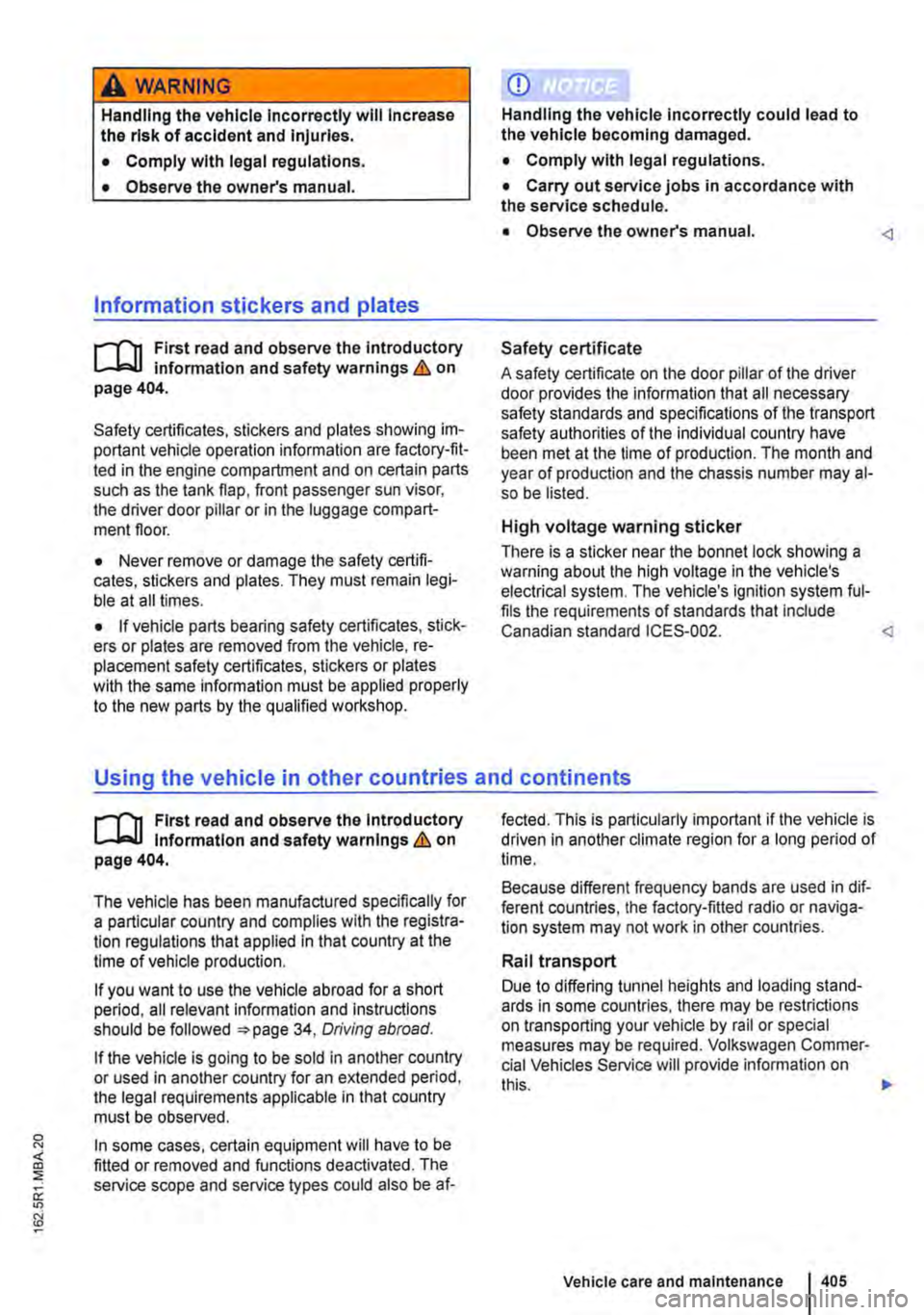
A WARNING
Handling the vehicle Incorrectly will Increase the risk of accident and Injuries.
• Comply with legal regulations.
• Observe the owner's manual.
Information stickers and plates
r--('n First read and observe the introductory L-1=.1.1 information and safety warnings & on page 404.
Safety certificates, stickers and plates showing im-portant vehicle operation information are factory-fit-ted in the engine compartment and on certain parts such as the tank flap, front passenger sun visor, the driver door pillar or in the luggage compart-ment floor.
• Never remove or damage the safety certifi-cates, stickers and plates. They must remain legi-ble at all times.
• If vehicle parts bearing safety certificates, stick-ers or plates are removed from the vehicle, re-placement safety certificates, stickers or plates with the same information must be applied properly to the new parts by the qualified workshop.
CD
Handling the vehicle incorrectly could lead to the vehicle becoming damaged.
• Comply with legal regulations.
• Carry out service jobs in accordance with the service schedule.
• Observe the owner's manual.
Safety certificate
A safety certificate on the door pillar of the driver door provides the information that all necessary safety standards and specifications of the transport safety authorities of the individual country have been met at the time of production. The month and year of production and the chassis number may al-so be listed.
High voltage warning sticker
There is a sticker near the bonnet lock showing a warning about the high voltage in the vehicle's electrical system. The vehicle's ignition system ful-fils the requirements of standards that include
r--('n First read and observe the lntrod uctory L-Jo-ll Information and safety warnings & on page 404.
The vehicle has been manufactured specifically for a particular country and complies with the registra-tion regulations that applied in that country at the time of vehicle production.
If you want to use the vehicle abroad for a short period, all relevant information and Instructions should be followed 34, Driving abroad.
If the vehicle is going to be sold in another country or used in another country for an extended period, the legal requirements applicable in that country must be observed.
In some cases, certain equipment will have to be fitted or removed and functions deactivated. The service scope and service types could also be af-
fected. This is particularly important if the vehicle is driven in another climate region for a long period of time.
Because different frequency bands are used in dif-ferent countries, the factory-fitted radio or naviga-tion system may not work in other countries.
Rail transport
Due to differing tunnel heights and loading stand-ards in some countries, there may be restrictions on transporting your vehicle by rail or special measures may be required. Volkswagen Commer-cial Vehicles Service will provide information on
Vehicle care and maintenance 405
Page 410 of 486

If and when
Practical tips
Frequently asked questions
If you suspect that a vehicle fault has arisen or your vehicle has been damaged, read and observe the following information before contacting a Volkswagen Commercial Vehicles dealership or
qualified workshop. You may also find useful infor-mation in the index under the headings "Things to note" or "Checklist".
To note Some possible causes Possible solution
Vehicle battery is discharged. -How to jump start =>page 443. -Recharge vehicle battery 362.
Engine does not start. The incorrect vehicle key is be-Use a valid vehicle key 36. ing used.
Fuel level is too low. Fill the tank 340.
Supplementary heating system Switch off the supplementary heating
Smoke is coming from the is running. system 332. wing. Supplementary heater is run-No solution 345. ning.
-Battery in the remote control -Replace the battery 36. Vehicle cannot be locked or key is flat. -Move closer to the vehicle. unlocked with the remote -Located too far away from the -Synchronise the vehicle key =>page 36. vehicle. control key. -Buttons were pressed outside -Lock or unlock the vehicle manually
the range. 413.
Cold engine. brake assist sys-Refer to the index under entries for Unusual noises. tems, supplementary heating "Noises". system.
Assist systems are active. Refer to the index under entries for "As-sist systems". Unusual handling. DSG® dual clutch gearbox is too Stop the vehicle immediately hot. 266.
Front seats cannot be ad-Vehicle battery is discharged. Recharge vehicle battery 362.
justed electrically. Fuse blown. Check fuse and replace as necessary 429.
The vehicle has no vehicle No direct solutions possible as it depends
jack, spare wheel or break-Equipment depends on type of on the equipment level. Contact a Volks-vehicle. wagen Commercial Vehicles dealership if down set. necessary 416.
-Windows or sliding roof are open. The interior monitoring sys--Item attached to the interior Remove any objects that could trigger a tem triggers a false alarm. mirror is moving. false alarm 44. -A mobile telephone is vibrating inside the vehicle.
Functions are not working Settings have been made in the Check and if necessary reset back to fac-as described in the owner's manual. Volkswagen information system. tory settings 24.
410 I If and when
Page 411 of 486
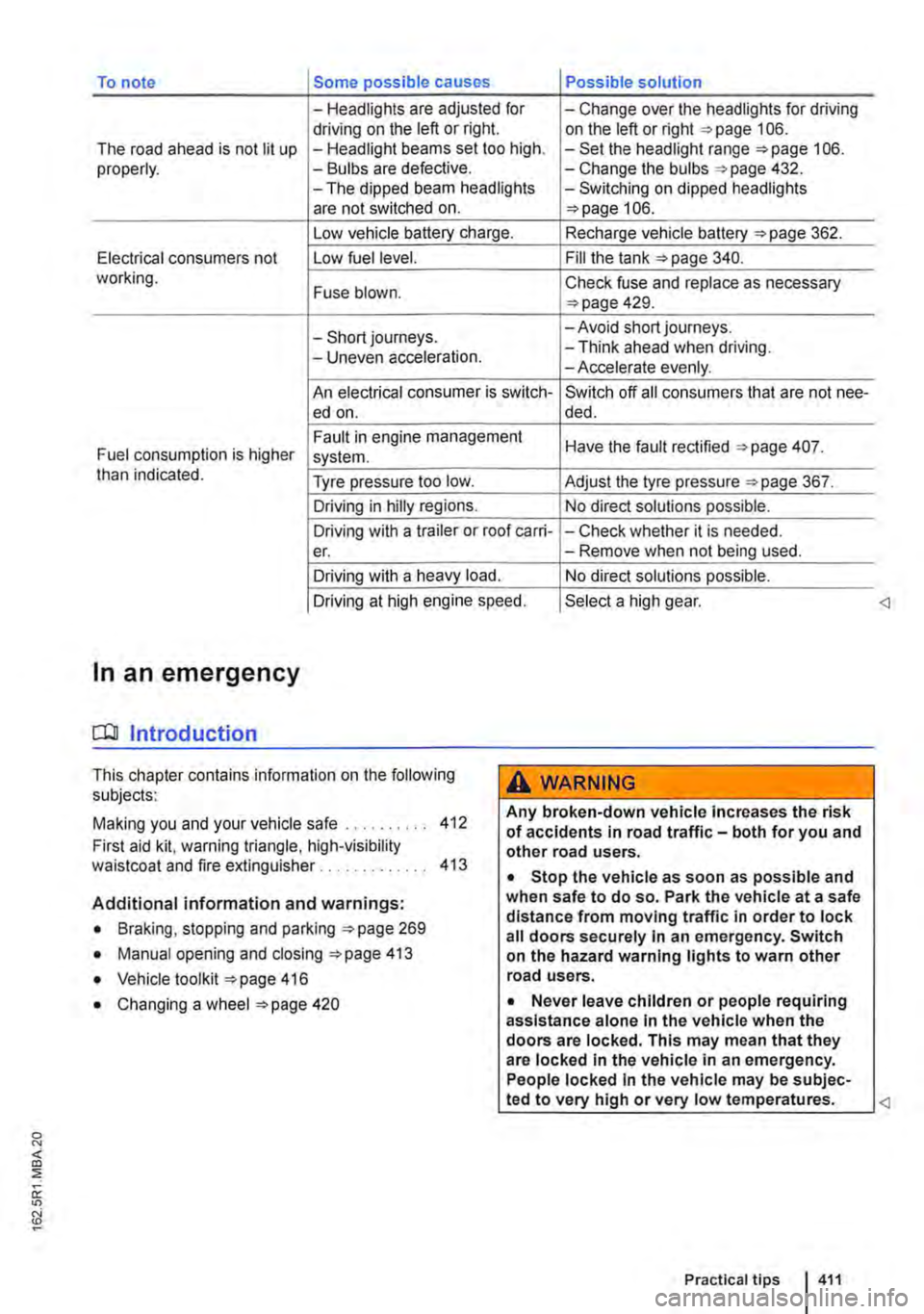
To note Some possible causes Possible solution
-Headlights are adjusted for -Change over the headlights for driving driving on the left or right. on the left or right 106. The road ahead is not lit up -Headlight beams set too high. -Set the headlight range 106. properly. -Bulbs are defective. -Change the bulbs 432. -The dipped beam headlights -Switching on dipped headlights are not switched on. 106.
Low vehicle battery charge. Recharge vehicle battery 362.
Electrical consumers not Low fuel level. Fill the tank 340. working. Fuse blown. Check fuse and replace as necessary 429.
-Short journeys. -Avoid short journeys.
-Uneven acceleration. -Think ahead when driving. -Accelerate evenly.
An electrical consumer is switch-Switch off all consumers that are not nee-ed on. de d.
Fault in engine management Have the fault rectified 407. Fuel consumption is higher system. than indicated. Tyre pressure too low. Adjust the tyre pressure 367.
Driving in hilly regions. No direct solutions possible.
Driving with a trailer or roof carri--Check whether it is needed. er. -Remove when not being used.
Driving with a heavy load. No direct solutions possible.
Driving at high engine speed. Select a high gear.
In an emergency
COl Introduction
This chapter contains information on the following subjects:
Making you and your vehicle safe . . 412
First aid kit. warning triangle, high-visibility waistcoat and fire extinguisher . . . . . . . . . . . . . 413
Additional information and warnings:
• Braking, stopping and parking 269
• Manual opening and closing 413
• Vehicle toolkit 416
• Changing a wheel 420
A WARNING
Any broken-down vehicle Increases the risk of accidents in road traffic-both for you and other road users.
• Stop the vehicle as soon as possible and when safe to do so. Park the vehicle at a safe distance from moving traffic In order to lock all doors securely In an emergency. Switch on the hazard warning lights to warn other road users.
• Never leave children or people requiring assistance alone In the vehicle when the doors are locked. This may mean that they are locked In the vehicle in an emergency. People locked In the vehicle may be subjec-
Page 413 of 486
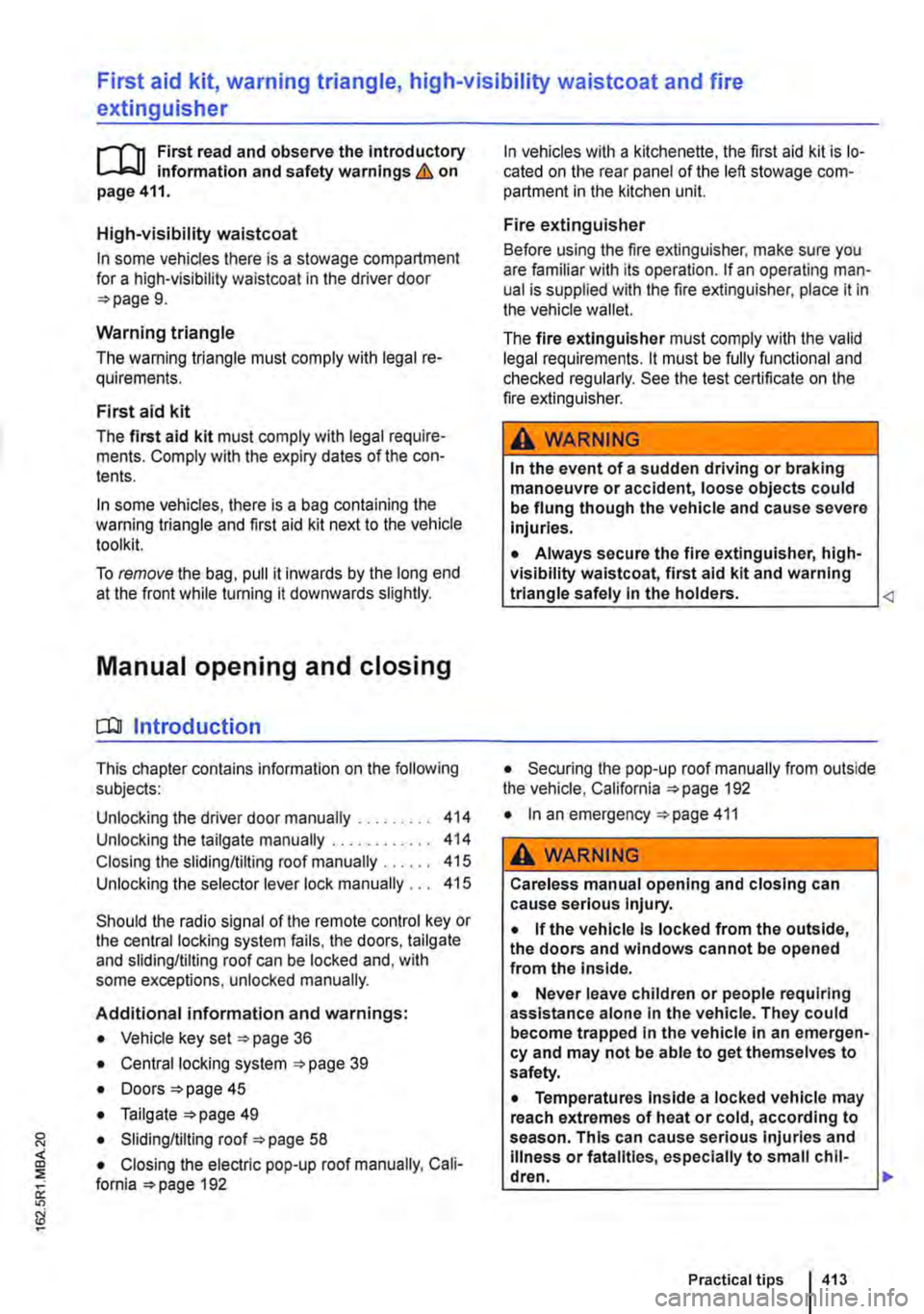
First aid kit, warning triangle, high-visibility waistcoat and fire
extinguisher
l"'""'('n First read and observe the introductory L.-J,::,JI Information and safety warnings & on page 411.
High-visibility waistcoat
In some vehicles there is a stowage compartment for a high-visibility waistcoat in the driver door 9.
Warning triangle
The warning triangle must comply with legal re-quirements.
First aid kit
The first aid kit must comply with legal require-ments. Comply with the expiry dates of the con-tents.
In some vehicles, there is a bag containing the warning triangle and first aid kit next to the vehicle toolkit.
To remove the bag, pull it inwards by the long end at the front while turning it downwards slightly.
Manual opening and closing
COl Introduction
This chapter contains information on the following subjects:
Unlocking the driver door manually . . . . . . . . . 414 Unlocking the tailgate manually ............ 414
Closing the sliding/tilting roof manually . . . . . 415
Unlocking the selector lever lock manually . . . 415
Should the radio signal of the remote control key or the central locking system fails, the doors, tailgate and sliding/tilting roof can be locked and, with some exceptions, unlocked manually.
Additional information and warnings:
• Vehicle key set 36
• Central locking system 39
• Doors 45
• Tailgate 49
• Sliding/tilting roof 58
• Closing the electric pop-up roof manually, Cali-fornia 192
In vehicles with a kitchenette, the first aid kit is lo-cated on the rear panel of the left stowage com-partment in the kitchen unit.
Fire extinguisher
Before using the fire extinguisher, make sure you are familiar with its operation. If an operating man-ual is supplied with the fire extinguisher, place it in the vehicle wallet.
The fire extinguisher must comply with the valid legal requirements. lt must be fully functional and checked regularly. See the test certificate on the fire extinguisher.
A WARNING
In the event of a sudden driving or braking manoeuvre or accident, loose objects could be flung though the vehicle and cause severe Injuries.
• Always secure the fire extinguisher, high-visibility waistcoat, first aid kit and warning triangle safely In the holders.
• In an emergency 411
A WARNING
Careless manual opening and closing can cause serious Injury.
• If the vehicle Is locked from the outside, the doors and windows cannot be opened from the inside.
• Never leave children or people requiring assistance alone In the vehicle. They could become trapped In the vehicle In an emergen-cy and may not be able to get themselves to safety.
• Temperatures Inside a locked vehicle may reach extremes of heat or cold, according to season. This can cause serious Injuries and Illness or fatalities, especially to small chil-dren. .,.
Practical tips 413
Page 414 of 486
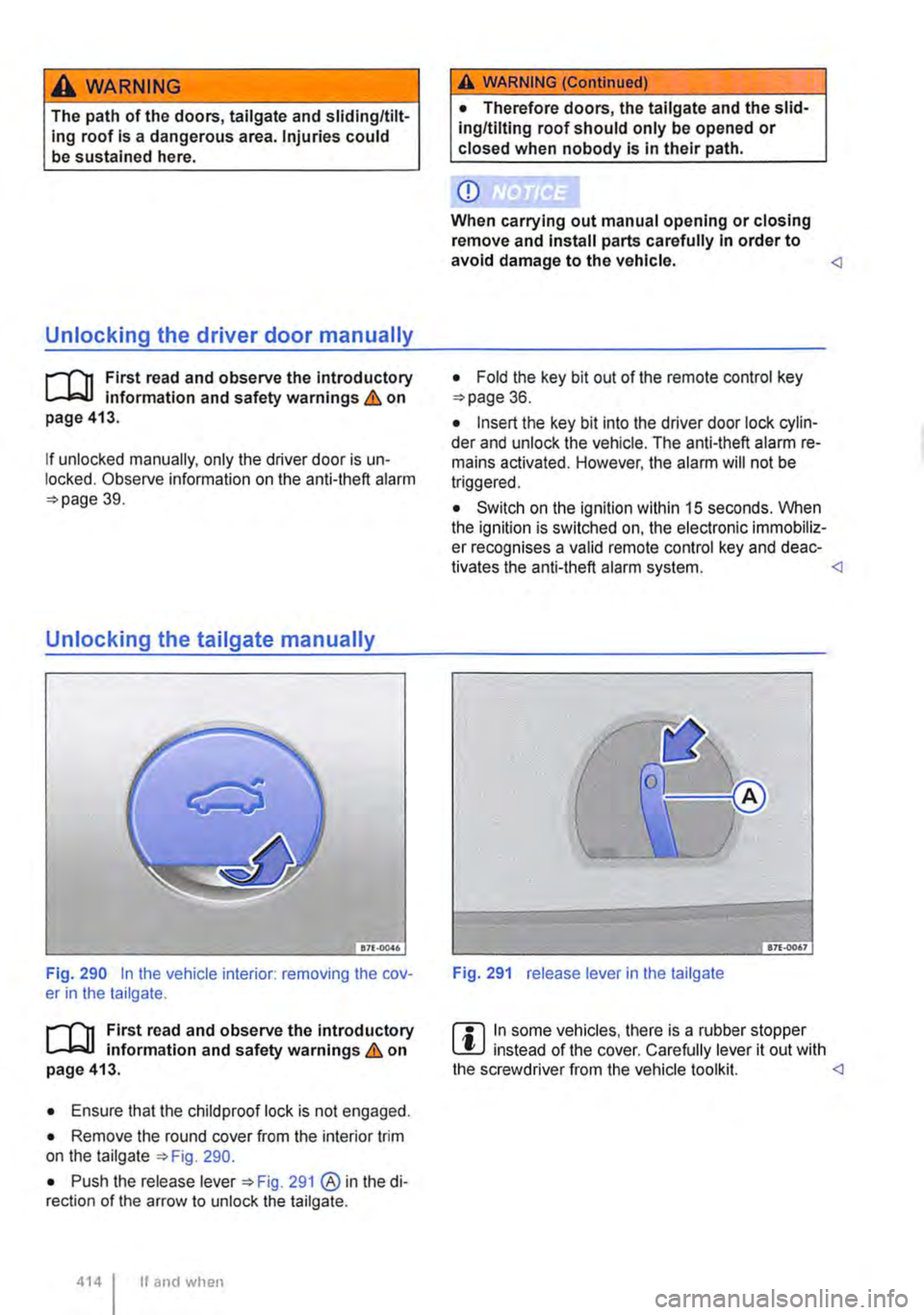
A WARNING
The path of the doors, tailgate and sliding/tilt-ing roof is a dangerous area. Injuries could be sustained here.
Unlocking the driver door manually
rl'11 First read and observe the introductory L-J.:.I.I Information and safety warnings & on page 413.
If unlocked manually, only the driver door is un-locked. Observe information on the anti-theft alarm 39.
Unlocking the tailgate manually
Fig. 290 In the vehicle interior: removing the cov-er in the tailgate.
rl'11 First read and observe the introductory L-J.:.I.I information and safety warnings & on page 413.
• Ensure that the child proof lock is not engaged.
• Remove the round cover from the interior trim on the tailgate 290.
• Push the release lever 291 @ in the di-rection of the arrow to unlock the tailgate.
4141 If and when
A WARNING (Continued)
• Therefore doors, the tailgate and the slid-ing/tilting roof should only be opened or closed when nobody is in their path.
CD
When carrying out manual opening or closing remove and Install parts carefully In order to avoid damage to the vehicle.
• Insert the key bit into the driver door lock cylin-der and unlock the vehicle. The anti-theft alarm re-mains activated. However, the alarm will not be triggered.
• Switch on the ignition within 15 seconds. When the ignition is switched on, the electronic immobiliz-er recognises a valid remote control key and deac-tivates the anti-theft alarm system.
m In some vehicles, there is a rubber stopper l!.J instead of the cover. Carefully lever it out with the screwdriver from the vehicle toolkit.
Page 415 of 486
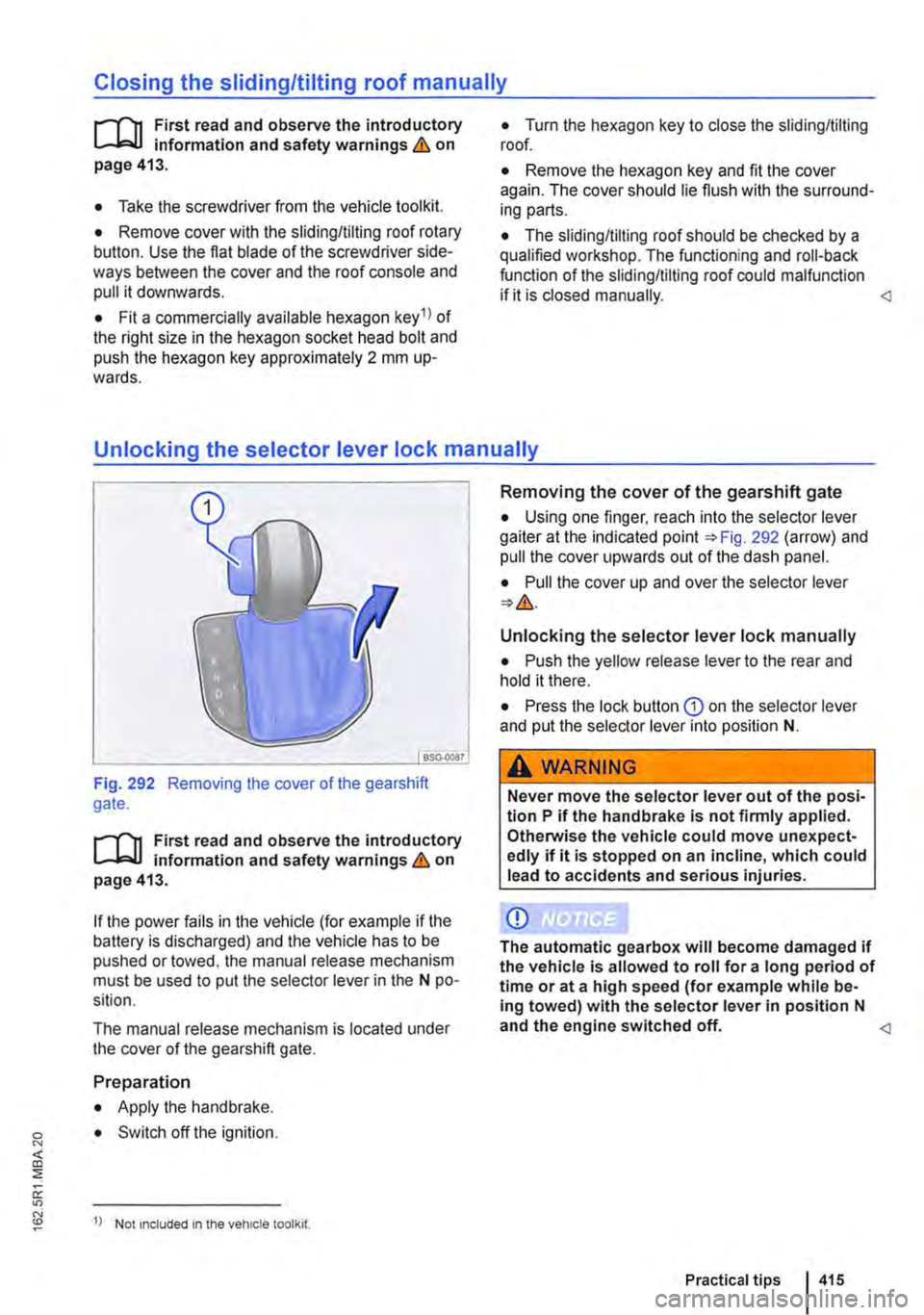
Closing the sliding/tilting roof manually
r-111 First read and observe the introductory L-J,.:.U information and safety warnings & on page 413.
• Take the screwdriver from the vehicle tool kit.
• Remove cover with the sliding/tilting roof rotary button. Use the flat blade of the screwdriver side-ways between the cover and the roof console and pull it downwards.
• Fit a commercially available hexagon key1) of the right size in the hexagon socket head bolt and push the hexagon key approximately 2 mm up-wards.
• Turn the hexagon key to close the sliding/tilting roof.
• Remove the hexagon key and fit the cover again. The cover should lie flush with the surround-ing parts.
• The sliding/tilting roof should be checked by a qualified workshop. The functioning and roll-back function of the sliding/tilting roof could malfunction if it is closed manually.
BSG-
r-111 First read and observe the introductory L-J,.:.lJ information and safety warnings & on page 413.
If the power fails in the vehicle (for example if the battery is discharged) and the vehicle has to be pushed or towed, the manual release mechanism must be used to put the selector lever in the N po-sition.
The manual release mechanism is located under the cover of the gearshift gate.
Preparation
• Apply the handbrake.
• Switch off the ignition.
< CD
;;;: "' 1) Not included in the vehicle toolkit.
Removing the cover of the gearshift gate
• Using one finger, reach into the selector lever gaiter at the indicated Fig. 292 (arrow) and pull the cover upwards out of the dash panel.
• Pull the cover up and over the selector lever
Unlocking the selector lever lock manually
• Push the yellow release lever to the rear and hold it there.
• Press the lock button G) on the selector lever and put the selector lever into position N.
A WARNING
Never move the selector lever out of the posi-tion P if the handbrake is not finnly applied. Otherwise the vehicle could move unexpect-edly if it is stopped on an incline, which could lead to accidents and serious injuries.
CD
The automatic gearbox will become damaged if the vehicle is allowed to roll for a long period of time or at a high speed (for example while be-ing towed) with the selector lever in position N and the engine switched off.